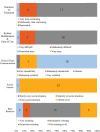A Retrospective Review of Outcomes and Complications after Infant Ear Molding at a Single Institution
- PMID: 37636327
- PMCID: PMC10448938
- DOI: 10.1097/GOX.0000000000005133
A Retrospective Review of Outcomes and Complications after Infant Ear Molding at a Single Institution
Abstract
Background: The purpose of this study was to evaluate outcomes and complications associated with infant ear molding at a single institution.
Methods: We conducted a retrospective chart review of all infants who underwent ear molding using the EarWell Infant Ear Correction System with pediatric plastic surgery from October 2010 to March 2021. Types of ear anomalies, age at initiation, duration of treatment, gaps in treatment, comorbidities, and complications were extracted for included patients. The primary outcomes assessed were degree of ear anomaly correction and incidence of skin complications. Parents were also sent a questionnaire regarding their long-term satisfaction with the ear molding treatment process.
Results: A total of 184 ears of 114 patients meeting inclusion criteria were treated during the study period. Mean age at treatment initiation was 21 days, and average duration of treatment was 40 days. Helical rim deformities (N = 50 ears) and lop ear (N = 40 ears) were the most common anomalies. A total of 181 ears (98.4%) achieved either a complete (N = 125 ears, 67.9%) or partial correction (N = 56 ears, 30.4%). The most common complications were eczematous dermatitis (N = 27 occurrences among 25 ears, 13.6%) and pressure ulcers (N = 23 occurrences among 21 ears, 12.5%). Infants who experienced a complication were 3.36 times more likely to achieve partial relative to complete correction (P < 0.001; 95% confidence interval 1.66-6.81).
Conclusion: Ear molding is an effective treatment strategy for infant ear anomalies, with most patients achieving complete correction.
Copyright © 2023 The Authors. Published by Wolters Kluwer Health, Inc. on behalf of The American Society of Plastic Surgeons.
Conflict of interest statement
The authors have no financial interest to declare in relation to the content of this article.
Figures







Similar articles
-
Efficacy of Ear Molding in Infants using the EarWell Infant Correction System and Factors Affecting Outcome.Plast Reconstr Surg. 2019 Oct;144(4):648e-658e. doi: 10.1097/PRS.0000000000006057. Plast Reconstr Surg. 2019. PMID: 31568305
-
Ear molding in newborn infants with auricular deformities.Plast Reconstr Surg. 2010 Oct;126(4):1191-1200. doi: 10.1097/PRS.0b013e3181e617bb. Plast Reconstr Surg. 2010. PMID: 20453717
-
Long-Term Effectiveness of Ear Molding and Factors Affecting Outcomes.Plast Reconstr Surg. 2024 Apr 1;153(4):905-913. doi: 10.1097/PRS.0000000000010678. Epub 2023 May 15. Plast Reconstr Surg. 2024. PMID: 37184475
-
A 10-Year Retrospective Review of the Nonsurgical Treatment of Infant Ear Anomalies.Plast Reconstr Surg. 2022 Nov 1;150(5):1049e-1056e. doi: 10.1097/PRS.0000000000009638. Epub 2022 Aug 24. Plast Reconstr Surg. 2022. PMID: 35998128 Review.
-
Evolution of Anomaly-Specific Techniques in Infant Ear Molding: A 10-Year Retrospective Study.Plast Reconstr Surg. 2022 Aug 1;150(2):394-404. doi: 10.1097/PRS.0000000000009335. Epub 2022 Jun 8. Plast Reconstr Surg. 2022. PMID: 35671454 Review.
Cited by
-
A Study on the Nonsurgical Correction Treatment Age Window and Long-Term Follow-Up of Infants With Congenital Ear Anomalies in China.J Craniofac Surg. 2024 Apr 26;35(6):1838-43. doi: 10.1097/SCS.0000000000010125. Online ahead of print. J Craniofac Surg. 2024. PMID: 38666783 Free PMC article.
-
Long-term Outcomes of Infant Ear Molding: A 10-year Single-Surgeon Experience.Plast Reconstr Surg Glob Open. 2025 Apr 15;13(4):e6673. doi: 10.1097/GOX.0000000000006673. eCollection 2025 Apr. Plast Reconstr Surg Glob Open. 2025. PMID: 40237007 Free PMC article.
References
-
- Byrd HS, Langevin CJ, Ghidoni LA. Ear molding in newborn infants with auricular deformities. Plast Reconstr Surg. 2010;126:1191–1200. - PubMed
-
- Niemelä BJ, Hedlund A, Andersson G, et al. . Prominent ears: the effect of reconstructive surgery on self-esteem and social interaction in children with a minor defect compared to children with a major orthopedic defect. Plast Reconstr Surg. 2008;122. - PubMed
-
- Chan SL, Lim GJ, Por Y, et al. . Efficacy of ear molding in infants using the earwell infant correction system and factors affecting outcome. Plast Reconstr Surg. 2019;144:648–658. - PubMed
-
- Ushiyama T, Ueyama H, Inoue K, et al. . Expression of genes for estrogen receptors alpha and beta in human articular chondrocytes. Osteoarthritis Cartilage. 1999;7:560–566. - PubMed
-
- Kenny FM, Angsusingha K, Stinson D, et al. . Unconjugated estrogens in the perinatal period. Pediatr Res. 1973;7:826–831. - PubMed
LinkOut - more resources
Full Text Sources
